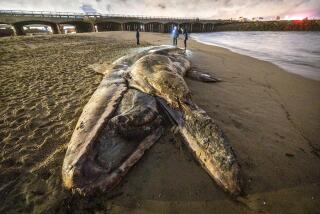Stranded Florida whales move to deeper water; outlook still grim
Florida whales that were trapped in water only a few feet deep Wednesday moved to deeper waters Thursday morning, but prospects for the animals remained grim, wildlife officials said.
More than 50 short-finned pilot whales were stranded in shallow waters on the western boundary of Everglades National Park by Tuesday afternoon. When a rescue team arrived Wednesday morning, six had died, and four were in such bad condition that they were euthanized, officials said.
The whales had somehow traveled 20 miles east of their deep-water habitat. Attempts to herd them back to safety failed, in part because the whales must traverse sandbars and shallow water to reach the deeper ocean.
It looked like the whales’ luck was changing Thursday morning, though. The Coast Guard found between 30 and 35 whales nine miles north of their previous location, swimming in 12 feet of water, Kim Amendola, communications specialist with National Oceanic and Atmospheric Administration, told the Los Angeles Times.
However, they are now even farther from their natural habitat, and getting them home still presents a challenge.
“The situation is fluid and changing by the minute,” Amendola said.
A team of 25 members of the National Park Service, the Marine Mammal Conservancy, the Fish and Wildlife Conservation Commission, the National Park Service and the National Oceanic and Atmospheric Administration are working at the scene to figure out why the whales stranded themselves.
The future for the whales does not look good.
“Most of these mass strandings that occur do not have a successful outcome, and we’re lucky if we’re able to even save a couple,” said Blair Mase, southeast marine mammal stranding coordinator for NOAA, on Wednesday.
The pilot whale is the most common species that mass strands in Florida, Mase said. Twenty-two were stranded in 2012, and 23 in 2011.
An adult weighs between 2,000 and 6,000 pounds.
Short-finned pilot whales typically travel in groups of 25 to 50, according to the NOAA fisheries website. The large groups make it even more difficult to herd them out of a dangerous area, Mase said.
Twitter: @skarlamangla
soumya.karlamangla@latimes.com
More to Read
Start your day right
Sign up for Essential California for news, features and recommendations from the L.A. Times and beyond in your inbox six days a week.
You may occasionally receive promotional content from the Los Angeles Times.







